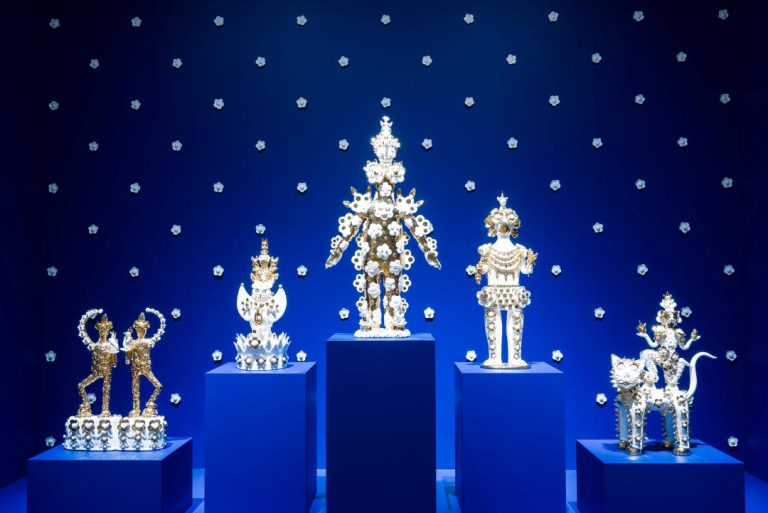We acknowledge the Traditional Owners of the land on which the Queensland Art Gallery | Gallery of Modern Art stands and recognise the creative contribution First Australians make to the art and culture of this country.

Vipoo Srivilasa / Thailand/Australia b.1969 / Shrine of Life / Benjapakee Shrine (installation view) 2021 / Mixed-media installation with five ceramic deities / Installed dimensions variable / Purchased 2021 with funds from the Contemporary Patrons through the QAGOMA Foundation / Collection: QAGOMA / © Vipoo Srivilasa / Photograph: Natasha Harth, QAGOMA
Vipoo SrivilasaShrine of Life / Benjapakee Shrine 2021
Not Currently on Display
Vipoo Srivilasa’s Shrine of Life / Benjapakee Shrine pays homage to his identity and builds on the audience-oriented nature of his previous works. The shrine-like sanctuary houses five contemporary deities Srivilasa has made to represent qualities important to him: identity, love equality, spirituality, creativity and security.
Infused with the scent of jasmine — familiar to worshippers at Thai temples where the blooms are offered as phuang malai (garlands) — the structure makes reference to the Lak Mueang shrine in the centre of Bangkok, which is distinguished by its white and gold architecture and is similarly protected by five Thai deities.1 Srivilasa recalls visiting Lak Mueang to pay his respects and ask for blessings before he left Thailand for Australia, and his artwork venerates this memory and acknowledges what the relocation has meant to him. ‘Love equality’, for example, comments on same-sex marriage, which was legalised in Australia in 2017, allowing Srivilasa and his partner to wed, but is yet to be endorsed in Thailand. The king penguins included allude to celebrated gay penguin couple Skipper and Ping in Zoo Berlin, while the arms of the figures that are yet to meet signify an incomplete heart — and Thailand’s ongoing journey towards marriage equality.
Bridging the sacred and the secular, Srivilasa’s shrine is both a personal expression of devotion and an invitation to visitors to request blessings and protection from one of the deities by making an offering of a paper flower to them. By providing a space in which to reflect and express gratitude, Vipoo Srivilasa shares something of his holistic approach to life and asks audiences to join him in honouring our differences and our commonalities.
Endnotes:
1 The number five is significant in Buddhist culture: Benjapakee are the sets of five grand Buddhist amulets that are most revered — benja meaning five and pakee meaning associates. The word refers to the five followers the Buddha gathered around him at the deer park at Isipatana, where he delivered his first teachings or Dharma.
Ceramic artist Vipoo Srivilasa practises art with a spirit of generosity, optimism and inclusion. Community-minded and attuned to contemporary concerns such as social justice and the migrant experience, he addresses these issues through artworks that offer hope for our troubled times.
Srivilasa is known primarily for his meticulously crafted blue-and-white porcelain sculptures that celebrate his Buddhist faith, the folktales and iconography of his Thai homeland and his life in Australia.
The blue-and-white palette Srivilasa has typically favoured references Lai Krarm, or Thai domestic tableware and, more broadly, the ceramics produced from the ninth century onwards in China’s Henan province, which were traded through the Middle East via the Silk Road and later imported to Europe. Srivilasa recognises the importation of blue-and-white ware as analogous to his own journey from East to West, and embraces the cross-cultural exchange it has entailed. ‘Nowadays,’ he says, ‘I find it hard to tell which culture is which in my work . . . The boundary is a blur.’1
Endnotes:
1 Vipoo Srivilasa, quoted in Alice Pung, ‘The colonisation of the cute – exploring the work of Vipoo Srivilasa’, Garland Magazine no. 6, 10 March 2017, accessed April 2021.